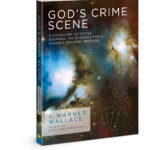
I pulled my wallet from my pocket and opened the money section. I showed him the single dollar bill in the billfold (I seldom carry cash when an ATM card will suffice), and simply asked him to help me understand how the money got there. Clearly, the dollar bill is an amazing object. It contains so much detail; specific numbers and drawings and words are inked on the paper. It is clearly the result of a design process. “So, Dad, how did the dollar bill get in the wallet?” He gave me the most obvious and reasonable explanation: he said I put the bill in the wallet. Actually, anyone could have placed the bill in the wallet, but since he saw me take the wallet from my pocket, he reasonably inferred I was the person who placed the dollar there. His answer made sense in light of the physical evidence.
I asked him, however, to limit his answer to wallet’s interior. I encouraged him to explain how the bill got in the wallet, but to provide an answer from inside the billfold exclusively. I can’t be the answer, given this new limitation, as I exist outside the wallet. At first he resisted. The limitation seemed unreasonable. How could the dollar get in the wallet if it wasn’t placed in there by someone or something outside the wallet? I asked him to play along with my thought experiment, however, and when he was unable to think of how the dollar got there, I offered him two creative explanations: (1) perhaps the dollar was always in the wallet. Maybe it is as old as the wallet and has always been there, or (2) perhaps the dollar formed over time from much more primitive materials in the wallet. Neither answer seemed reasonable to my father.
“You see”, I told my dad, “with this simple illustration I’ve described the problem philosophical naturalists and materialists have when they try to explain how life began in the universe.” How does matter come from non-matter? How does life come from non-life? If only natural forces are in play, we simply cannot go outside the physical realm for an answer. In essence, we cannot go outside the wallet. Life in this universe is either infinitely old, or it has evolved over time. But of course, these two explanations have inherent problems exposed by the fields of philosophy and science.
The scientific study of the universe is replete with evidence the universe had a beginning. In addition, the idea the universe and life within the universe is infinitely old suffers from an infinite regress problem. In addition, if time had no beginning, it would be impossible for us to get to today. And any discussion of evolution as a solution to our dollar bill problem still requires us to explain how the base material for the dollar got in the wallet in the first place. If life evolved from primal matter, how did this primal matter come into existence? We’ve simply pushed our dilemma back one level. Naturalism must explain how the pieces required for the formation of the dollar got in the wallet in the first place.
Clearly the most satisfying answer for how a highly designed object appears within the wallet is to conclude someone placed the object in the wallet. When we force ourselves to limit our answers to sources inside the wallet, we create an unreasonable (and biased) restriction. The most unbiased approach would at least allow us to consider explanations exterior to the wallet. In a similar way, it seems to me the most unbiased science would also respect the reasonable inference the supernatural might be in play.
I used this illustration to help my dad understand why I am not satisfied with a naturalistic answer related to life within the universe, and to explain the reason why I think supernatural theism is the only reasonable inference. But let’s face it, this approach, at best, simply illustrates the reasonableness of theism. It does nothing to bring me to the conclusion that Christianity is true. I needed to take two more small steps with him. I’ll describe these steps in my next two posts. In the meantime, I’ve created a video to help you take the first step in this process:

J. Warner Wallace is a Dateline featured Cold-Case Detective, Senior Fellow at the Colson Center for Christian Worldview, Adj. Professor of Christian Apologetics at Talbot School of Theology, Biola University, author of Cold-Case Christianity, God’s Crime Scene, and Forensic Faith, and creator of the Case Makers Academy for kids.
Subscribe to J. Warner’s Daily Email
J. Warner Wallace is a Dateline featured cold-case homicide detective, popular national speaker and best-selling author. He continues to consult on cold-case investigations while serving as a Senior Fellow at the Colson Center for Christian Worldview. He is also an Adj. Professor of Christian Apologetics at Talbot School of Theology, Biola University, and a faculty member at Summit Ministries. He holds a BA in Design (from CSULB), an MA in Architecture (from UCLA), and an MA in Theological Studies (from Gateway Seminary).

































Pingback: Links to consider and share - 9/4/2014
Pingback: Hyperlinks to think about and share – 9/four/2014 | Posts